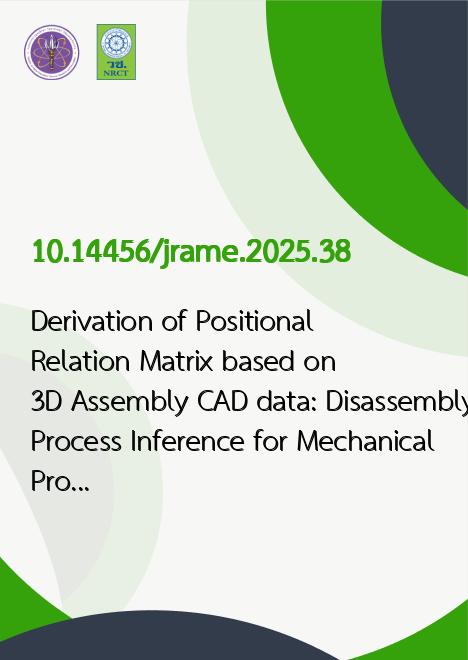
|
Derivation of Positional Relation Matrix based on 3D Assembly CAD data: Disassembly Process Inference for Mechanical Products |
|---|---|
| รหัสดีโอไอ | |
| Creator | 1. K. Yamada 2. K. Takahashi 3. K. Hanahara |
| Title | Derivation of Positional Relation Matrix based on 3D Assembly CAD data: Disassembly Process Inference for Mechanical Products |
| Publisher | Thai Society of Mechanical Engineers (TSME) |
| Publication Year | 2568 |
| Journal Title | Journal of Research and Applications in Mechanical Engineering (JRAME) |
| Journal Vol. | 13 |
| Journal No. | 3 |
| Page no. | JRAME-25-13-038 (p.1-8) |
| Keyword | Disassembling process, Positional Relations Matrix, Separating-Axis Theorem, Maintenance Support, Collision Detection |
| URL Website | https://ph01.tci-thaijo.org/index.php/jrame/index |
| Website title | Journal of Research and Applications in Mechanical Engineering (JRAME) |
| ISSN | 2229-2152 |
| Abstract | During machine maintenance, the disassembly task is more challenging than the assembly task because the disassembling process involves more patterns and possibilities than the assembling process, depending on the reasons or objectives of disassembling. In addition, an incorrect disassembly may cause machine damage or human operator injuries. Lists and instruction manuals of parts have been used for machine disassembly; however, these manuals cannot include all parts in general, and the disassembly of some parts is difficult for unskilled operators. Therefore, the disassembly process inference is crucial. In order to infer the disassembly process, a positional relation matrix consisting of the relative positional relationship between any two components is required to clarify the disassembly process. Currently, the matrix is derived manually; however, an automatic generation approach is required to reduce the computation effort. In this study, a method was developed to automatically generate a positional relation matrix based on the geometric information of machine part models, which can be obtained from three-dimensional assembly data of a computer-aided design. A case study was conducted using the proposed method, and it was confirmed that the method could generate positional relation matrix for disassembly. |
